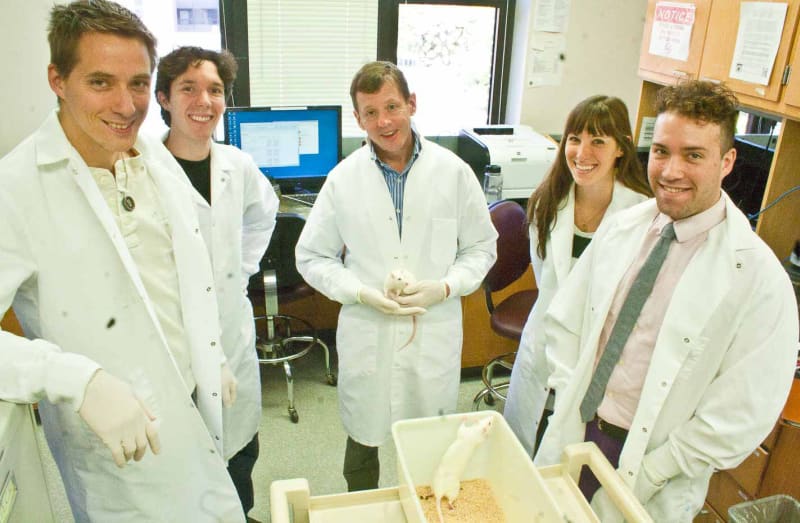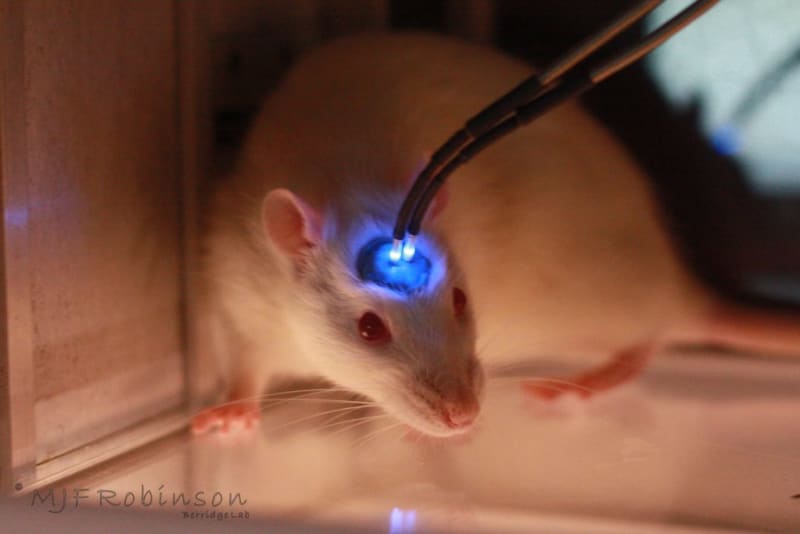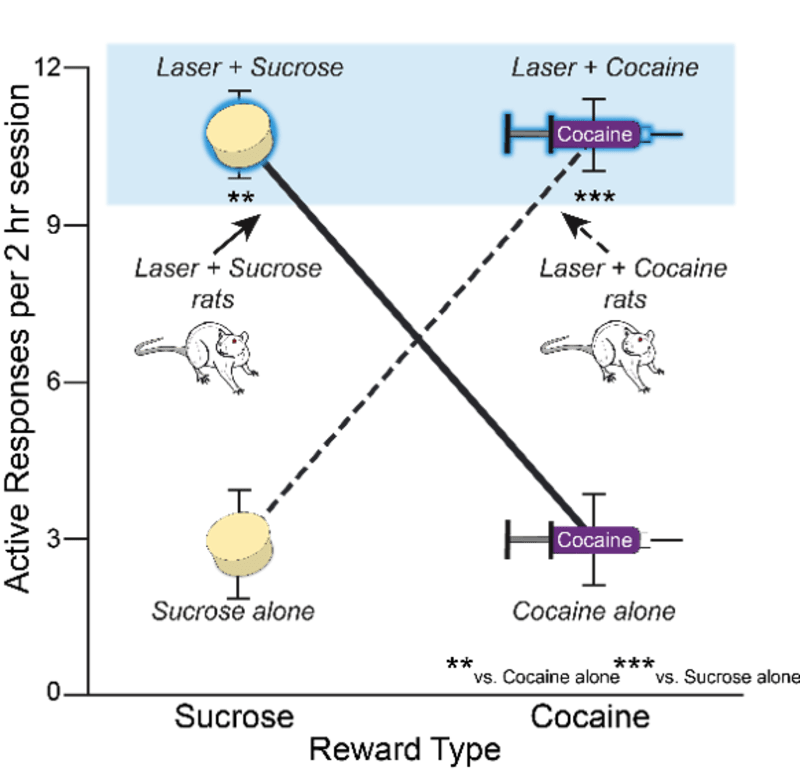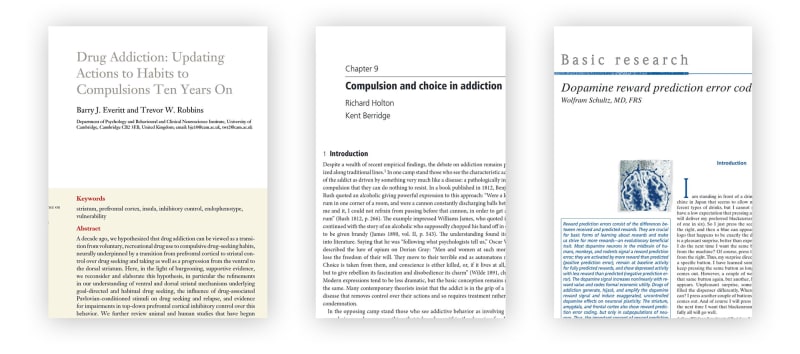Kent Berridge on Dopamine, Addiction, and Neuroscience
Contents
Kent Berridge is a distinguished professor of psychology and neuroscience at the university of Michigan and the joint recipient of the 2019 Grawemeyer Award for psychology. Through experiments on rodents, his research addresses questions about how pleasure is generated in the brain, the relation of fear to desire, and what causes addiction.
We begin by discussing the ‘prediction error’ theory of associative learning, and the role of dopamine between pleasure and wanting. Kent introduces his ‘incentive salience’ theory of addiction, and we consider the role of pleasure. Then we hear about Kent’s recent experimental results involving shining lasers into the brains of rats on cocaine. Kent and his team have apparently found a way of making rats become addicted to electric shocks. We discuss the implications for our view of human addiction, and if the results suggest new kinds of treatment. Finally, Kent reflects on how he has changed his mind during his career.
Prediction error
Prediction error is a simple kind of ‘Pavlovian’ or ‘classical’ conditioning. It is a way humans and animals come to associate stimuli with outcomes. These can be positive (appetitive) or negative (aversive) reactions: for instance an organism might learn to approach the smell of nice food, or feel nauseous and disgusted by the smell of rotting food. A cue or stimulus signals some outcome. When they are new, the stimuli often start with neutral relevance. Learning requires that the occurrence of the outcome is unexpected or surprising. With each pairing of the cue and its outcome, expectation of the outcome increases and surprise decreases. Take Pavlov’s dogs as an example. When they first heard the bell before their food arrived, they did not associate the sound of the bell with food, so the bell was not useful for predicting the onset of food. The arrival of food was therefore surprising (assuming it was not dinner time!) and the dogs had failed to predict it. Eventually, the bell is associated with food and the dogs become less and less surprised when food arrives after the bell is rung. When previously the dogs salivated when the food arrived, now they salivate when they hear the bell. It’s as if the bell itself has the same significance of the arrival of food. This whole process is modeled by the Rescorla-Wagner rule.
Don’t worry if this is too complicated: the key idea is that neutral cues are gradually associated with an outcome over time. The prediction error is the difference between the actual and predicted outcomes. Pavolv’s dogs didn’t have to do anything to receive their food; but this applies equally to cases where animals learn some behaviour which gets a reward. For instance, a mouse might discover which button releases a sugar pill, and repeatedly press it. Dopamine fits into this story because it signals reward prediction errors: dopamine neurons are activated (at least in humans, monkeys, and rodents) when the organism receives more reward than predicted. In short, dopamine helps us learn to strongly associate cues with rewards. Ideally, that provides ‘motivational oomph’ to get us to seek out those things we desire. It’s useful, for instance, to learn to strongly desire sugary foods in an evolutionary environment in which they are scarce.
Drugs like alcohol, amphetamines, and alcohol “seem to hijack the neuronal systems that have evolved for processing natural rewards” (Schulz). This is because they artificially stimulate a release of dopamine just like in cases of genuine, useful reward prediction error learning. Schulz continues, “this stimulation is not limited by the sensory receptors that process the environmental information, because the drugs act directly on the brain”.
That, at least, was the story before Kent Berridge and his laboratory began to examine the ‘prediction error’ story of dopamine and addiction. Berridge admits -
When a reward value is being determined solely by new increments in learning… in that situation, the dopamine neurons follow the temporal difference model beautifully.
However, the first place the story begins to come apart is when the cue being has not been experience before, and doesn’t fit in to an existing ‘model’ of the world. But cues are not always like this; some learning is ‘model-based’. Here’s an experiment Kent mentions: take some Dead Dea salt water, which is three times saltier than normal seawater. Now introduce a rat to two levers. One lever would be paired with a release of sugary water, and it does not take long for the rats to become fixated with activating the sugar water lever. The other lever released salty water. The rats would quickly learn to avoid activating that lever. Now the rats are placed into brain states that mimic the effects of sodium deficiency (salt appetite), such that the salty water would be delicious and good for the rat. The question is, when the rat wakes up in this state, would the rat have to gradually learn to press the salty-water lever more often? The prediction error model says yes, because the rats have learned a strong aversive (negative) reaction to the lever which can only be reversed after successive trials. If, for instance, the salty water were replaced by sugar water, the rats would take a few tentative trials before becoming confident that the lever is reliably paired with a good outcome. But that is not what happened: when the rat woke up, it jumped on the salt water lever without any period of relearning. Berridge notes that there’s no way the standard model-free prediction error story can make sense of this.
Previously, it was assumed that the ‘mesolimbic dopamine system’ (and just dopamine in general) was responsible for the experience of pleasure. The story went that substances like sugar or cocaine would trigger a release of dopamine which signaled that this feels good and would thereby lead to associative learning through prediction error. But Berridge’s work shows that the mesolimbic dopamine system is in fact associated with wanting instead. Dopamine-deprived rats still appear to enjoy the same substances, and elevated dopamine levels do not appear to increase liking. Liking, or pleasure, in fact seems to be associated with a more delicate and distributed series of small ‘hotspots’ in the brain. Berridge describes the process of moving away from this theory in the interview:
I was absolutely convinced that dopamine was pleasure when I began my career, I loved that hypothesis and we started our experiment intending to add one more little bit of evidence to the conclusion that dopamine was pleasure. It was painful, literally painful, to have results that didn’t fit that.
The Incentive Salience theory
Berridge and his colleague Terry Robinson developed an updated theory of addiction called the ‘incentive salience’ theory, which says that the essence of drug addiction is amplification of wanting (particularly triggered by drug-related cues) without any necessary amplification of liking (Berridge & Robinson). The theory, Berridge says, derives from the psychology of motivation. Most of the thinking in the 60s and earlier said that we are motivated to do things in order to avoid nasty things. This is called drive reduction. For instance, we are plausibly motivated to seek out food because hunger is uncomfortable. But this turned out not to be wholly accurate. As Berridge puts it, “the taste of the food is far more motivating than just making hunger go away.” Most of us knows what it feels like to really want to eat some food despite knowing we’re not hungry, and don’t need to eat. Incentive salience says that often the cue is wanted (and liked) as if it is the reward.
‘Liking’ here just means actually enjoying something when you get it, while ‘wanting’ means having some reason or motivation to get it. It isn’t immediately obvious that you ever need to draw a distinction between wanting and liking. Don’t we basically always want what we like, and like what we want? Berridge’s theory says otherwise: the key insight is that wanting and liking are often totally separable. In cases of addiction, the incentive salience theory says that addicts experience a ‘hyperactivity’ of wanting in response to drug-related cues. Sometimes this extreme level of wanting is useful: if we were starved of food for days on end, we would begin to obsess and dream of food. But addiction appears to be a case of this system misfiring - Berridge describes it as “a starved want in an unstarved brain”.
It is important to distinguish the wanting of the incentive salience theory from conscious, cognitive wants which you can reason about, visualise, plan around, and so on. Beridge relates the two kinds in the sense that, “The mesolimbic wanting system evolved to give motivational oomph to the things you already want.” The two can occur together, to be sure; but they can also pull in opposite directions. And it is this strange thought that it might be possible to really want something you know you won’t like, that Berridge’s recent experiments explore.
Optogenetics
In the recent series of experiments which he describes in the interview, Berridge and his team used a technique called optogenetics. First, a virus is used which carries the gene for opsin photoreceptors. The virus is then gutted / sterilised so that it can’t reproduce, before being injected into a specific area of the rat’s brain. In Berridge’s case, it was injected into a region of the amygdala. The neurons in the brain with this new gene begin to make photoreceptor (light-sensitive) molecules that twist in light. So now, when wavelengths of light are fired on those neurons, they activate (by transferring certain ions). Finally, that brain region is targeted with a fiber-optic cable attached to a laser. A cap is placed on the open cut-away area of the rat’s head, and the rats are anesthetised during the entire process, so they wake up having experiences no pain. The result is that this very specific region of their brains can effectively be ‘activated’ with millisecond-precision. I think it’s worth pausing to appreciate how amazing that all is!
Rats, lasers, and electric shocks
Berridge and his team used optogenetic techniques in a recent series of experiments investigating the effects of activating the central amygdala on the intensity and focus of wanting.
In the first experiment Berridge describes, a mouse is presented with two buttons, both of which release a sugar pill when the mouse nibbles them. For one of the levers, the laser is activated just when the rat nibbles it. The rats became fixated on the lever paired with the laser activation at the total expense of the other lever; even when there was a time delay between successive deliveries of sugar pills which mean the rat could get more sugar pills if it nibbled both levers. When the sugar pills are swapped out for intravenous doses of cocaine.
In the second experiment, one lever was paired with sugar pills and the other with cocaine. Regardless of whether the laser was paired with the cocaine or with the sugar pill, the rats inevitably became fixated on the lever paired with the laser.
The natural explanation for this is just that the laser itself is a kind of reward for the rats - this would explain the previous two experiments because the laser just acts like more reward. But, surprisingly, this is not the case: rats do not just ‘want’ laser. This can just be showed by giving the rats a choice between a lever that releases a sugar pill or cocaine hit, and a lever that activates the laser. In that choice, the rats did not become interested in the laser lever, and always preferred the sugar / cocaine lever.
A very similar explanation is that the laser makes the rats ‘like’ the sugar or cocaine more (remember the wanting / liking distinction). Maybe it’s just really nice to have your amygdala zapped by blue light! But when the rats facial expressions are compared between laser+sugar and sugar alone, we see no significant difference. So that explanation doesn’t seem quite right either. Instead, So somehow the laser is directing the focus of wanting toward whatever reward it is paired with.
Things get even stranger when Berridge and his team paired the laser with frightening or painful targets. This time, the rats were placed in enclosures with a metal rod which delivers a nasty electric shock. When the laser was not paired with the shock, rats would maybe take a couple of nibbles of the rod before very quickly learning not to do so again. But when the laser did activate just when the rats received a shock, the rats became fixated on the rod, just like they were fixated on the levers which delivered sugar or cocaine. Somehow, activating the central amygdala when the rats nibbled the electric shock rod made the rats want to do it more. Yet just as in the cases of sugar and cocaine, the laser did not appear to make the rats remotely like the shocks any more than normal, or enjoy the laser itself. In other circumstances, the laser activation of the central amygdala increased fear reactions - so its effect seems to depend on the circumstances in ways which are not fully understood.A final curious piece of this story is that when the laser was paired with a neutral stimulus, like a dummy rod which did not give electric shocks, the rats did not become fixed on it like they did when it did give painful shocks. So there is something about the fact that the stimulus has some valence, whether negative or positive, that is necessary for activation of the central amygdala to lead to strong wanting and addictive behaviour. When I described all this to my little sister, she asked me whether a laser like that could make her really want to do her homework. I guess so!
Although the central amygdala is normally associated with fearful responses, in these experiments it has focused the target of appetitive responses - of wanting rather than aversion. Why this is the case, and why activating the central amygdala can cause aversive learning to ‘flip’ to appetitive learning, is the mystery that these experiments leave us with.
Implications for human addiction
Of course, for the most part scientists use experiments on rats because they hope what they learn might transfer in some relevant way to humans. Incidentally, this excellent Twitter account exists solely to call out over-hasty generalisations from rodents to humans.
Broadly speaking, there are two rough view about what goes on in human addiction. This is, necessarily, a gross simplification of the existing views of addiction; but as Berridge writes in a paper co-authored with philosopher Richard Holton, “despite a wealth of recent empirical findings, the debate on addiction remains polarized along traditional lines.” One camp sees addiction as a kind of disease involving “pathologically intense” compulsions which are near-impossible to resist. For instance, William James quotes an alcoholic saying:
Were a keg of rum in one corner of a room, and were a cannon constantly discharging balls between me and it, I could not refrain from passing before that cannon in order to get at the rum.
Similarly, Oscar Wilde describes opium addiction in The Picture of Dorian Gray:
Men and women at such moments lose the freedom of their will. they move to their terrible end as automatons move. Choice is taken from them, and conscience is either killed, or, if it lives at all, lives but to give rebellion its fascination and disobedience its charm.
The other camp sees addiction as a more standard kind of choice based on reasons, desires and beliefs; while being subject to self-control. It might still be true that an addict would experience very painful withdrawal symptoms were they not to continue taking their drug, but they make the decision to do so, roughly speaking, on the basis of considering what would be the best thing to do or what would lead to the best balance of pleasure over pain. Members of this camp point out that addicts respond to incentives in apparently standard ways: Berridge and Holton write “Anesthesiologists and airline pilots who, having been once detected in their addiction, are required to pass random and frequent drug tests on pain of dismissal, are remarkably good at giving up.” Opponents of this view frame it as an all-too-convenient way of blaming addicts for behaviour which is, in truth, beyond their control.
Berridge’s research suggests a kind of middle path between these two views. On one hand, the authors write:
There is good evidence that the brain of an addict is importantly different from that of a normal non-addicted individual—indeed there is even some reason to think that the addict’s brain might have started out with a vulnerability to addiction. Certainly once addiction is under way, the desire for the addictive drug takes on a life of its own, with an intensity that is particularly, perhaps uniquely, high… More surprisingly, addicts need not even like the thing that they are addicted to: they need gain no pleasure from it, nor anticipate that they will. Nor need they be motivated by a desire to avoid the horrors of withdrawal. Alcohol or heroin addicts often relapse long after withdrawal is over[.]
On the other hand, “[t]he intensity and power of an addictive desire does not mean that addicts are automata, standing powerless spectators as they are moved by their desires. For whilst addictive desires are very strong, the human capacity for self-control is also highly developed; much more developed, it seems, than in rats.” So addiction is best understood as an extremely powerful desire (‘want’) for a drug that is nonetheless answerable to willpower and self-control. Other views of addiction see drug addiction as a kind of powerful habit that persists despite the addict’s best intentions to quit; or else as developing from the disproportionate amount of pleasure that drugs give. The habit account seems to omit the powerful desires associates with addiction (compare biting your nails with drinking water after being stranded in the desert). The pleasure account has an element of truth - obviously taking drugs is often extremely pleasurable for addicts. But it seems to assume that the mesolimbic dopamine system is associated with liking rather than wanting, which Berridge’s research contradicts. Moreover, suppressing the dopamine system does not seem to diminish the pleasure they derive from sweet foods (judging by their facial expressions). Nor do elevated dopamine levels in humans lead to higher subjective ratings of pleasure.
A frightening fact about drug addiction is that an addict can quit, and endure withdrawal symptoms for some length of time before they eventually fade away. Yet even many years later, seeing a drug-related cue can re-ignite long-dormant desires to relapse that apparently come out of left-field and take the addict by surprise. In fact, these urges that develop during the so-called ‘incubation period’ (often during rehab) can be stronger than they were originally. Berridge mentions that there is some research that indicates this long-term learned wanting might be reversible in rats, and perhaps one day in humans; but that we shouldn’t hold out for such an outcome in the near future.
Reading recommendations
- Dopamine reward prediction error coding by Wolfram Schultz
- Drug Addiction: Updating Actions to Habits to Compulsions by Barry J. Everitt and Trevor W. Robbins (plus its follow-up).
- Compulsion and choice in addiction by Kent Berridge and Richard Holton
- Liking, Wanting and the Incentive-Sensitization Theory of Addiction by Terry Robinson
Click here for a big list of Professor Berridge’s publications, plus photos and brief explanations. Click here for the Berridge Lab website, with some cool photos of the experiments.
This article does not necessarily accurately represent the present views of the guest.




